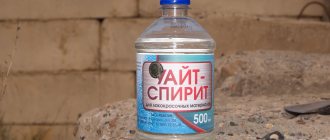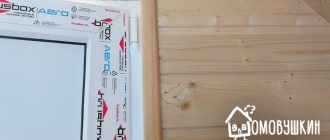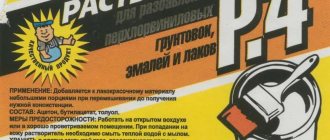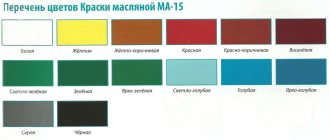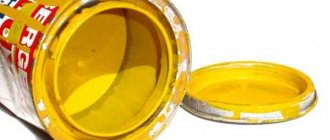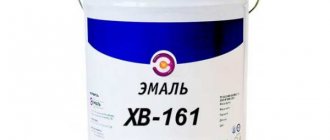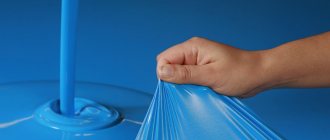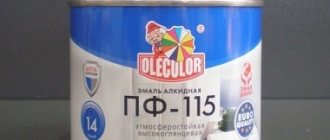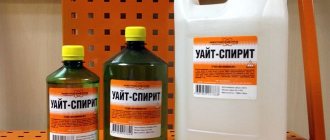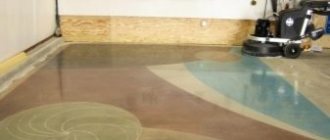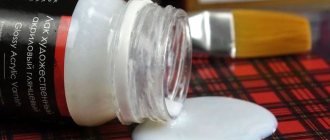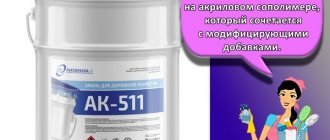During construction and repairs, situations often arise when paint or putty needs to be thinned a little. For this purpose, special compounds are used that do not change the qualities of the source material. White spirit is considered one of the most popular and inexpensive.
What is white spirit?
The composition is one of the types of organic solvents that are obtained through direct oil refining. The name literally translates as “white spirit”. White spirit is a composition that is an oily liquid, classified as a substance with a low level of danger, but if the vapors are inhaled for a long time, symptoms of poisoning may appear. In simple words, this is one of the varieties of light fractions of kerosene or dehydrated purified gasoline. As a result of containing a large amount of volatile substances, it cannot be used as a fuel.
White spirit - composition
The second name of the substance is “Nefras-C4”. It belongs to the group of mixed solvents, which include hydrocarbons of all classes in an amount of 5% of the total mass. The substance does not have any specific formula, because it is made by distillation, and it is impossible to say exactly what the composition will be, because everything depends on the source raw material. There is a type of solvent gasoline that has virtually no odor, this is obtained due to additional purification.
About existing analogues
If white spirit is not available, you can use similar substances that can replace it.
The main thing is that the properties of such compositions are approximately the same:
- Solvents grades P4, 650, 649, 646, 647;
- Acetone;
- Solvent;
- Turpentine;
- Petrol.
Analogues are practically no different from white spirit, except that in some properties they will be slightly worse. It is better to leave them as a last resort, when the most basic material is really gone.
White spirit - technical characteristics
The main indicators of the substance according to GOST are as follows:
- permissible density of white spirit at +20°C – 0.790 g/cm³;
- boiling point – +160°C;
- 10% is distilled at a temperature of – +170°C;
- 90% – +195°С;
- 200% – +98°С;
- residue after distillation – 6%;
- flash point – +33°С;
- volatility for xylene – 3-4.5;
- mass fraction of aromatic hydrocarbons – 16%;
- sulfur – 0.025%;
- White spirit hazard class – 4.
Additional information about storage
The materials are highly flammable. The main thing is that children cannot access the room, while maintaining an adequate level of ventilation. Naturally, there should be no open sources of fire, as well as direct sunlight. If you use containers and canisters for storage, it is important that each one is tightly closed. White spirit is known for its low freezing point. Therefore, even rooms without heating are suitable for storage.
White spirit and kerosene - what's the difference?
These two compounds perform the same functions. Solvent white spirit and kerosene are mixed benzenes that obtain their properties after direct distillation of low-sulfur oil. Both compositions are used in everyday life and production. The fundamental differences between these materials are volatility and viscosity. Kerosene is slightly volatile when compared with the “white spirit”. After use, a thin oil film is formed on the surface. To treat the surface of, for example, a car, it is recommended to use white spirit, which has clear advantages over kerosene.
Surfaces and degreasing rules
Solvents contain several substances at once, or only one. In the production of such materials, it is permissible to use gaseous and solid, liquid forms of components. Liquid solvents have become more widespread.
There are a lot of factors that need to be taken into account to make the right choice.
Some of the characteristics are determined by the quality of the components and the manufacturing process. Example:
- The appearance of open fire;
- Chemical additives in a certain quantity;
- Acidity;
- Toxicity, and so on.
Solvents also differ in their range of applications:
- Medicine;
- Conducting laboratory research;
- Shoes;
- Manufacturing of leather goods;
- Chemical industry;
- Machine production;
- Instrumentation.
What is white spirit used for?
Characteristics such as low toxicity, fire hazard, cost-effectiveness and ease of use lead to widespread use in various fields. The main area of use of the product is the chemical industry. The purpose of white spirit is as a solvent in the manufacture of varnishes, paints, primers, enamels and other products. In addition, it is used in the following areas:
- Construction
. Reducing viscosity and diluting paints, varnishes and drying oils. This helps save paint without compromising the quality of the coating. In addition, white spirit is applied to degrease surfaces. - Automotive industry or car service
. The surfaces of various parts are degreased, components are washed, and mastics are prepared. - Leather industry
. Used to dilute compositions for tanning leather and imparting certain qualities to them. - Pharmaceutical industry
. The production process of certain medications. - At home
. During repairs, paints are diluted, and during maintenance, old grease is removed. In laundries it is used to remove various stains.
Does white spirit degrease or not?
The answer to this question is yes. Any metal products can be processed, especially those that are being prepared for painting. Having figured out whether it is possible to degrease a material with white spirit, you need to know that in addition to this, its processing does the following:
- removes all contaminants obtained during operation;
- remove traces of liquids with which the material has come into contact.
Having studied white spirit - what it is, it is clear that the effect of such operations is the appearance of small stains; if any coatings are then applied, this is not significant. In addition, white spirit is used for processing plastic and glass. The substance has a gentle effect on almost all objects. This is a suitable option for treating any surface before gluing.
Can paint be thinned with white spirit?
Initially, this composition was produced exclusively for these purposes. It is now very popular due to its availability and wide range of uses. When looking for information on how to dilute paint with white spirit, you need to know that the composition is suitable for oil and enamel types, as well as various paint and varnish products. Depending on the amount of solvent, it can be used not only to dilute liquid paint, but also to dissolve dried paint without damaging the surface.
Solvent products and their varieties
There are several groups of solvents that help solve different problems.
For oil-based paints and varnishes
- Petrol.
The composition is as simple as possible and does not create problems upon receipt. Characterized by combination with products of most varieties. Dissolves putties and enamels, alkyd and oil paints. Helps deal with pentaphthalic enamels, but less frequently.
- Turpentine.
Copes not only with oil base, but also with alkyd-styrene compositions. It is used when preparing varnishes based on dammar and rosin, copal.
- White Spirit.
Can dilute almost any type of paint used in practice. The same applies to varnishes and other similar products. Compatible even with PF-115 enamel. Suitable for washing hands after using enamels and paints. Copes with putties, bituminous materials, drying oils and primers. Degreases different types of surfaces.
How to use white spirit?
Once purchased, the composition does not require any preparation before use. Knowing that white spirit is a composition for solving many problems, you need to know how to use it correctly. To do this you need to follow a number of simple steps:
- open the lid and pour in a small amount of white spirit;
- stir well until a homogeneous mass is obtained;
- repeat all steps until the desired consistency is achieved.
One of the important parts of use is human safety rules when working with this substance. Precautions include the following:
- The use of protective clothing and a respirator is mandatory.
- It is necessary to ventilate the room, because a high concentration of vapors can affect the nervous system.
- Avoid exposure to direct sunlight, which can lead to fire.
- Close the lid tightly after use and store in a dark place.
- Prohibited use near open flames.
How to get rid of the smell of white spirit?
Despite the large number of positive aspects of use, there is one drawback - an unpleasant aroma that remains on all surfaces with which the composition came into contact. If it is not possible to purchase odorless white spirit, you need to know how to get rid of it. To get the desired result, you need to know the following methods:
- Things are soaked in clean water for 30 minutes. Then change the water and hand wash with laundry soap and washing powder. Rinse twice: in vinegar and soda, and then in clean water.
- After contact with skin, you need to shower and rub your body with antibacterial soap. The area can be wiped with a vinegar solution (1:1) or lemon zest.
- The smell of white spirit is removed from the car interior using coffee beans, soda or starch. Treat the surface with any method, remove the residue with a vacuum cleaner.
- You can refresh the room by hanging wet towels, ventilating the room, placing a container of water and mint, or turning on the aroma lamp.
- You can clean furniture or carpet with soapy water or coffee beans.
Storage and use
White spirit is a flammable substance (category 2), auto-ignition temperature is 270°C. Vapors mixed with air create an explosive mixture. Given these features, pay special attention to the storage location. This solvent should be kept in a dark, cool, ventilated room, out of reach of sunlight. There should be no heat sources nearby, including heating devices. The shelf life is usually indicated on the can, but it is not important. If there is liquid inside and not jelly, it can be used.
Packaged in plastic bottles and canisters
When opening and operating, the following requirements must be met:
- Work outside or in a well-ventilated area.
- It is unacceptable to be near open flames or sources of sparks.
- When opening the container and mixing the compositions, do not use devices that can create a spark.
- White spirit begins to evaporate at a temperature of +20°C. To ensure quick drying of paint, mastics, putty, you need to work in the warm season or in a warm room.
- If solvent is spilled in a room, open windows and doors, collect as much as possible, and remove it from the room. Wipe the area where white spirit was spilled with a rag. To remove grease stains, you can use detergents that dissolve fats. If you spill it on the street, fill the puddle with sand, which you then take out.
- In case of fire, do not extinguish it with water. Use foam, sand, powder, felt.
According to the degree of impact on the human body, it is classified as a substance with low danger. In case of contact with skin, it can cause burning, dermatitis and allergic eczema. Therefore, it is better to avoid even short contact. The best thing you can do is wear gloves. If you have to work indoors for a long time, it makes sense to wear a respirator.
What to replace white spirit with?
Given the great popularity of the composition, there is no need to be upset when it is not at hand at the right time. You can replace white spirit degreaser with the following substances:
- turpentine;
- gasoline;
- solvent P4;
- FAS-104;
- technical gasoline;
- solvent.
Currently, you can find a wide variety of solvents on sale, each with its own advantages and disadvantages, as well as application features and cost. There is no single alternative to replacing white spirit; in each individual case, you need to select a product based on the needs and specifics of using the composition.
Use at home
In comparison with analogues (solvent, solvent, degreaser), white spirit has low vapor volatility (low degree of evaporation), which makes it possible to use the composition indoors. There are many “folk” ways of using it that you might not know about.
Cleaning plastic windows from old film Source ytimg.com
Removing protective film from plastic windows that has become ingrained over time. and is applied to problem areas and remains until it is completely dissolved. If necessary, the procedure is repeated several times. After this, just wipe the frame with a damp cloth.
Cleaning tiles from silicone sealant Source wp.com
Plumbing sealant that gets on tiles or plastic is removed in the same way as the previously described method. Moisten the area of contact between the silicone and the surface with white spirit after 30 seconds. You can remove sealant that has dissolved to the point of melted oil.
White spirit for cleaning paint stains Source www.sedmoycanal.com
Clothes stained with bitumen or paint are cleaned with a piece of cotton wool soaked in white spirit. The stain is processed from the edge to the center. After a minimum period of time, only a wet spot will remain on the material. After this, rinse the item with water and washing powder. This cleaning principle will not harm even the most delicate fabrics.
White spirit as a means for cleaning leather shoes Source sdelai-lestnicu.ru
Removing bitumen from leather shoes follows a similar scenario. The only difference is that after cleaning is completed, the dried stain is wiped with a washcloth soaked in soapy water.
Healthy! Don't try to remove tough stains in one go. It is better to use several approaches with drying after each of them.
Removing greasy stains from parquet Source pol-exp.com
White spirit poisoning
Any solvent is toxic to the human body, therefore the use of white spirit is allowed only after using personal protective equipment for the skin and mucous membranes. The following toxic effects of the composition have been established:
- damage to the central nervous system;
- damage to the structure of the circulatory system;
- toxic liver damage;
- severe poisoning of kidney cells.
Similar problems can arise as a result of the following situations:
- lack of personal protective equipment;
- technical process failure;
- poor room ventilation;
- failure to comply with safety regulations;
- damage to the container in which white spirit is stored;
- accidental use.
If you detect the negative effects of white spirit, you should immediately go to the hospital. Poisoning is expressed:
- chest pain;
- pain in the stomach;
- nausea;
- vomiting blood.
Safety Compliance
Such compositions differ from analogues in the large number of chemically active substances in the composition. Because of this, people's health may suffer. Some substances are classified as explosive. Therefore, safety rules cannot be ignored.
The most important thing is to store materials only in the right conditions. There are not so many of them:
- Good ventilation.
- Ventilation.
Symptoms of poisoning include general weakness and lacrimation, dizziness with rapid pulse. When the smell is too strong, the health suffers first of all; a person feels it almost immediately.
If a substance is flammable, then it is prohibited to place it next to even simple hot objects, let alone high temperatures and sources of open fire. This rule is especially relevant for those who work with such compounds on an ongoing basis. It is better to choose formulations that have a gentle effect on internal organs.
Mandatory personal protective equipment includes:
- Thick gloves;
- Glasses;
- Respirators.
In their absence, there is a high probability of chemical burns.
If any drug comes into contact with the mucous membranes, immediate rinsing of the damaged areas is required. First take running water. Then, if possible, seek medical help.
Sometimes solvents are used to get rid of stains on clothes. But first, it is recommended to select a small piece of fabric to test the effect. Some products do the job of cleaning, but can damage the clothes themselves.
If these rules are followed, the use of solvents will become as simple and effective as possible.
Additional information on the use of solvents
- It is important to study the standards for all groups of paints and varnishes that promote anti-corrosion protection on buildings and individual elements. They are also used for other structures that complement the installation site;
- Regulatory documents are needed to calculate the need for a certain amount of materials, to control their consumption while construction and painting work is underway for specific objects;
- The standard for paint and varnish costs is the basis on which all further calculations are made;
- The standard is considered to be the amount of paint and varnish that is necessary to obtain a layer with a thickness of at least 1 micron on a surface of up to 1 m2. (example - in the first table);
- There are consumption standards - how much paint and varnish materials are spent per unit of production. It is established taking into account all factors that can influence the value. Now the standards assume that a unit of production is 1 ton of metal structures. (from table 2);
- The components of the auxiliary group include solvents with other additives from the composition of paintwork materials. This is an indispensable part of any kit when painting any surface. (Table 3);
- Depending on the cost norms, it is easy to learn about the features of a particular production in terms of technologies, designs, and work organization. After all the calculations, it is easier to use paintwork materials with maximum efficiency. There are fewer problems with the use of internal reserves and their preliminary identification.
Scope, purpose
White spirit is used mainly as a solvent for any fractions of oil, sulfur compounds, nitrogen, and oxygen. It can also dissolve vegetable fats.
The ability to dissolve fats is used if it is necessary to clean the surface before priming, applying paint, etc. It is actively used before applying paint and varnish coatings (LPC) to metals.
For cleansing
You should not use this solvent to clean fabrics or highly absorbent surfaces - you will struggle with the smell for a long time and persistently. It is very difficult to defeat him. The most effective method is treatment with hot (superheated) steam.
So that the substances that give the smell heat up and evaporate. It is worth knowing that white spirit begins to boil at 165°C, and evaporates completely at 200°C. If it is possible to heat the surface to a similar temperature, the volatile substances evaporate and the smell becomes less.
There are no such problems with smooth surfaces - it evaporates instantly. Outdoors or in a well-ventilated area, the smell is faint. During renovations and construction, mineral spirits can be used to remove old paint, putty, oil and grease stains. Another useful property is that it removes well the glue that remains after removing the tape and rosin stains.
White spirit is also used to degrease natural leather. Since there is no chlorine in the composition, it does not change the properties, color and texture. It can be used to protect or “treat” wood from mold and fungi.
The liquid penetrates deeply into the pores, destroying the source of damage. In addition, the paint adheres better and consumption is reduced. That is, white spirit can be used as a primer and antibacterial protection for wood.
As a solvent
Despite the fact that the dissolving ability of white spirit is average, it is often used for diluting many compositions to the desired consistency. In this case, a solvent is introduced into the composition, and not vice versa. Mix thoroughly until smooth.
As a solvent, white spirit is used with the following compositions:
- oil paints;
- antibacterial impregnation for wood;
- drying oil;
- alkyd enamels;
- alkyd varnishes;
- bitumen mastics;
- rubber mastics.
When combined with paint, white spirit reduces its viscosity. The composition is better applied and distributed, consumption is reduced. But it is worth remembering that after drying the surface will be glossy. If you need a matte finish, look for another solvent.
Dilute to a more liquid state with white spirit and putty. But only those that have an appropriate basis:
- ML - melamine,
- M - oil- and alkyd-styrene;
- PF - pentaphthalic;
- MP - urea;
- VN - divinylacetylene.
White spirit is popular among car owners as a means of removing car mastics. Cleans any bitumen-based compounds and oil shale mastics. Well removes lubricants that are used to treat parts to protect against corrosion (car preservatives).
Just remember that the liquid is highly corrosive. That is, you should not allow prolonged contact with the surface. If a puddle has formed, it must be quickly removed and the area wiped dry.
Applications: degreasing, diluting, cleaning
Nefras has a number of features. The advantages of this solvent:
- the pungent odor goes away quickly (in particular, this applies to Tikkurila brand products);
- inexpensive;
- relatively low consumption compared to other solvents.
Application of the substance:
- production of paints and varnishes;
- production of various mastics, polishing pastes and drying oils, materials for priming;
- cleaning of various equipment parts in industry;
- degreasing of various surfaces, mainly metal;
- fighting rust and removing bitumen stains from the body;
- production of antibacterial substances for wood;
- removes paraffin from the surface and fibers of fabric.
This list is not exhaustive. It is expanding with the development of various technologies.
Expert opinion
Ilya Vyacheslavovich
Consultant for body repair at krasymavto.ru
Ask a Question
Disadvantages of the solvent: explosive and flammable when accumulated in the room where it is used, the presence of an unpleasant odor and some toxicity at high concentrations.
Which is better: ours or imported?
Despite the fact that the production technology is the same, imported white spirit has a weaker odor (and higher prices). This is due to the fact that the product goes through more purification stages, which remove volatile compounds. It’s good - work is easier, there are no headaches and all other symptoms.
The bad thing is that during the cleaning process the dissolving power decreases. This means that fluid consumption will be greater. This is when we talk about adding to paints or mastics. The second point is that the stains will be scrubbed off worse.
This is if you use the substance as a stain remover. On the other hand, if you try to remove a stain from fabric with low-purity white spirit, it will be extremely difficult to get rid of the smell (note that repeated washing does not help). It’s clear that the less odorous the liquid, the easier the problem is to solve.
Perhaps for this reason, some manufacturers produce this type of solvent in several degrees of purification (for example, Tikkurilla - with blue and yellow labels). Different tools for different tasks.
